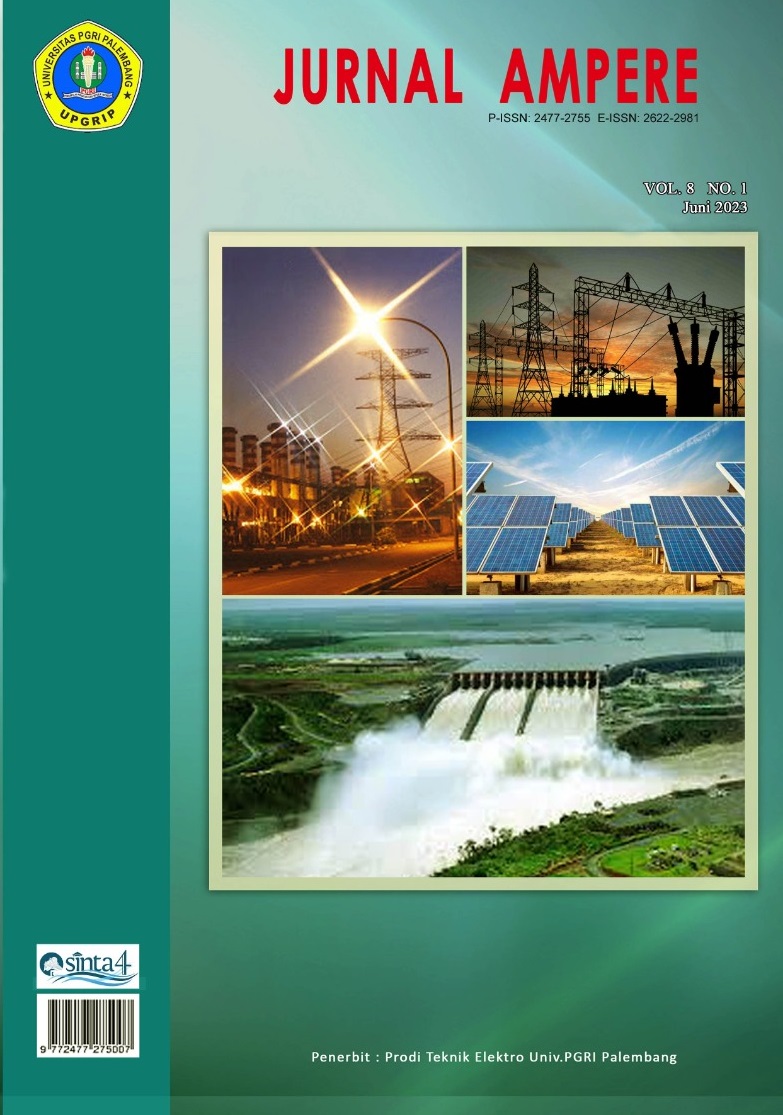Analisa Potensi Penggunaan PLTS On Grid di Kota Makasar
DOI:
https://doi.org/10.31851/ampere.v8i1.10958Keywords:
solar panels, PLTS on grid, energy, MakassarAbstract
Makassar is the center of government and business center in the province of South Sulawesi. The people of Makassar has a very high dependence on the use of electrical energy to meet their daily needs, both at home and at offices. The use of electrical energy which is quite high will cause an increase in customer bills every month. Therefore, this problem needs to be reduced by utilizing alternative energy sources. PLTS on grid is one of the solutions to reduce dependence on electrical energy from PLN. This research was carried out using a load simulation method based on the level of solar radiation in Makassar City at an installed power of 4500 VA. By using PLTS on grid the customer has two sources of electrical energy, from solar power and PLN line. The main source of electrical energy during the day is from on grid solar power and at night is from PLN line. If the power from the on grid solar power the day is insufficient to serve the load needs, PLN will automatically responsible for the electric power of the load. The simulation results show that the use of on-grid PLTS saves PLN's electricity consumption by 34.78% to 89.53%. These results illustrate that the potential for using on grid solar panels in the city of Makassar is very large
References
H. Suyanto, “Kajian Potensi Energi Surya Di Provinsi Nusa Tenggara Barat (NTB,” J. Energi Kelistrikan, vol. 8, no. 2.
M. Triyatni, Pengukuran Dan Pengolahan Data Komponen Iklim Di Makassar, Prosiding Temu Ilmiah IPLBI. UNHAS.
D. Septiadi, “Proyeksi Potensi Energi Surya Sebagai Energi Terbarukan,” J. Meteorol. Dan Geofis., vol. 10, pp. 22 – 28,.
S. Patabang and J. Leda, “Analisis Manfaat Alat Penghemat Listrik Rumah Tangga,” Pros. Semin. Has. Penelit., vol. 2018, pp. 97–102, 2018, [Online]. Available: http://jurnal.poliupg.ac.id/index.php/snp2m/article/viewFile/774/663
A. Prastawa, PLTS sebagai Sumber Daya Listrik Alternatif. Jakarta: Pusat Konservasi Teknologi, Badan Pengkajian dan Penerapan Teknologi.
Suryana, “Deny dkk, 2016, Pengaruh Temperatur / Suhu Terhadap Tegangan Yang Dihasilkan Panel Surya Jenis Monokristalin,” J. Teknol. Proses Dan Inov. Ind., no. 1, Vol. 2.
S. Patabang, “Pemanfaatan Panel Surya on Grid Pada Rumah Tinggal Berdasarkan Jumlah Beban,” Batara Wisnu Indones. J. Community Serv., vol. 2, no. 1, pp. 85–96, 2022, doi: 10.53363/bw.v2i1.72.
U.S.A.I.D., “Matahari Untuk PLTS di Indonesia.” [Online]. Available: http://www.litbang.esdm.go.id
U.S.A.I.D., “Panduan Perencanaan dan Pemanfaatan PLTS ATAP DI INDONESIA,” Indones. Clean Energy, [Online]. Available: https://drive.esdm.go.id/wl/?id=XOegh8pXO9FMjebl4x0joDD6hIZe94Fm&fbclid=IwAR3QqukFxECEuyMyDwwjtvJSRqzWGkW5ajYZkIB-nxI3nADqFY3wtPt-kuU
K. Tiyas and Puteri, “Pengaruh Efek Suhu Terhadap Kinerja Panel Surya,” J. Tek. Elektro, vol. 09.
Downloads
Published
How to Cite
Issue
Section
License
Copyright (c) 2023 Mr. Simon Patabang, Limbran Sampebatu, Aries Kamolan

This work is licensed under a Creative Commons Attribution-ShareAlike 4.0 International License.

Jurnal Ampere is licensed under a Creative Commons Attribution-ShareAlike 4.0 International License.
Authors who publish with this journal agree to the following terms:
- Authors retain copyright and grant the journal right of first publication with the work simultaneously licensed under a Creative Commons Attribution License that allows others to share the work with an acknowledgement of the work's authorship and initial publication in this journal.
- Authors are able to enter into separate, additional contractual arrangements for the non-exclusive distribution of the journal's published version of the work (e.g., post it to an institutional repository or publish it in a book), with an acknowledgement of its initial publication in this journal.
- Authors are permitted and encouraged to post their work online (e.g., in institutional repositories or on their website) prior to and during the submission process, as it can lead to productive exchanges, as well as earlier and greater citation of published work.






